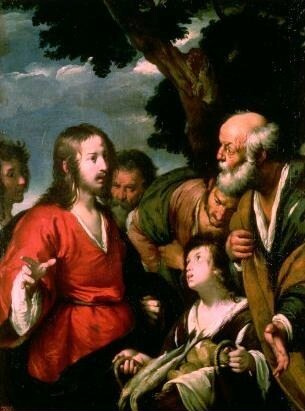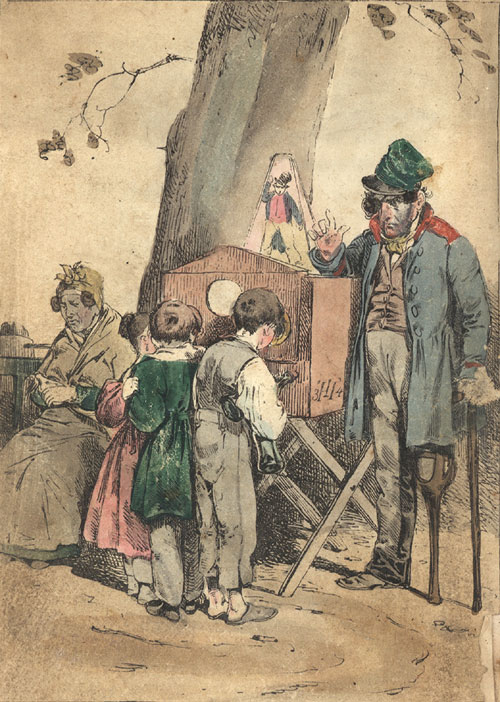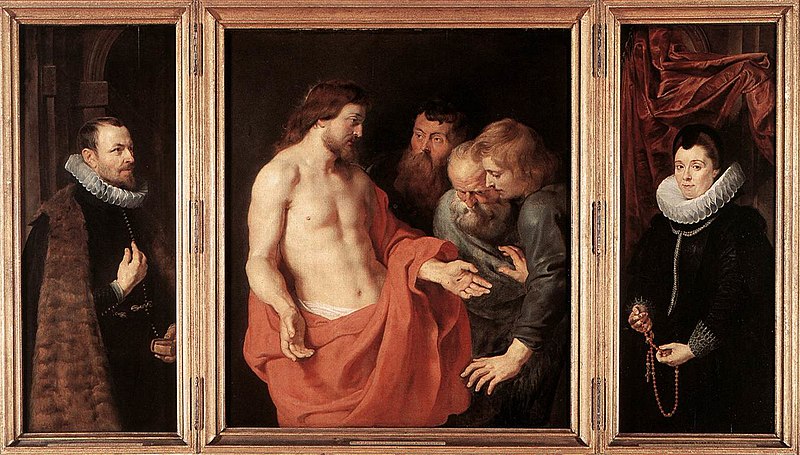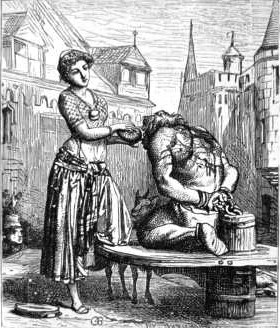
One artistic interpretation of the “miracle of the loaves and fishes…”
* * * *
Most people know the story of Jesus feeding 5,000 people with just a couple of fish and a loaf or two of bread. If you take the story literally, it’s about the “Son of God” performing a fairly routine feat of magic. If – on the other hand – you go beyond the fundamentals – beyond the traditional view – you might end up with a story that’s even more of a miracle.
Matthew 14:13-2 has one version of Jesus and His disciples going to a “lonely place apart.” (Apparently He was trying to keep the disciples from getting “burned out;” that is, suffering from a “general wearing out or alienation from the pressures of work.”)
 There was also the fact that Jesus and His disciples had just heard that King Herod had beheaded their friend, John the Baptist. (As shown at left.) However, when Jesus and the disciples tried to get away, a bunch more other people found out about it, and started following them.
There was also the fact that Jesus and His disciples had just heard that King Herod had beheaded their friend, John the Baptist. (As shown at left.) However, when Jesus and the disciples tried to get away, a bunch more other people found out about it, and started following them.
So Jesus took pity on this new bunch of needy people.
He proceeded to heal their physical problems, until it got to be evening. Then the disciples asked Jesus to send the crowd away. The place was either deserted and/or “a desert,” and there were no restaurants or convenience stores around.
But when Jesus told the disciples to feed the crowd, they said they only had five loaves of bread and two fish. So Jesus took the bread and the fish, told everyone to sit down, and started passing out food. Much to everyone’s surprise, there was enough to feed all 5,000 men. (This was “besides women and children,” so there were actually far more than 5,000 people who got fed.)
Aside from all that, there was enough to make 12 lunch-boxes of food for a next-day meal.
So far, so good.
In the traditional view, this was a pure miracle, plain and simple. In that view the miracle can’t be explained rationally, needn’t be explained rationally, and indeed, was never meant to be explained or understood rationally. Jesus did it, the Bible recorded it, “and there’s an end to it.”
But there is a non-traditional view.
In that view, by sharing what little food they had, Jesus and His disciples “induced many more people” – who had brought food with them, for their own use – to share their food with the less forward thinking, “and so enough was found for all.”
According to this non-traditional theory, the people of that day and age never went far from home without taking a spare loaf of bread – or some other non-perishable food – stashed somewhere in the folds of their robes. But that non-traditional view seems to threaten the faith of some Bible-readers, and it’s not clear why.

Maybe the Bible would be far more relevant today if it was about people just like us. So suppose the Bible was about – and was written by – people just like us today? What if those Bible-writers had all the faults and failings that we have, yet they somehow managed to personally experience the presence of God, the Force that Created the Universe.
But we digress…
Getting back to the loaves and fishes. If you view it literally, it doesn’t seem to prove a lot.
It does prove that God or His first-born Son had the power to see that those people – at that time and place – didn’t go hungry. But that might make some wonder why God can’t do the same thing today. So one implication from that “literalist” view seems to be that God could feed us all today, but maybe just “doesn’t care.”
So if this story is viewed too literally, it seems to prove only that Jesus could perform a miracle. It shows Jesus had the power to pull off a fairly routine feat of magic, but that’s pretty much what you would expect of the First-born Son of God.
But what if God didn’t intend this to be just another feat of magic?
Suppose the lesson Jesus intended to teach us was that – by His example – He got a bunch of normally-greedy people to share what they had. That by His example, Jesus got those normally-greedy people to share so much of their own stuff that no one – in the crowd of “5,000 plus” – went hungry. And more than that, there was even a surplus. The question is:
Which would be the greater miracle?
* * * *
 Another interpretation, by “Bernardo Strozzi…”
Another interpretation, by “Bernardo Strozzi…”
* * * *
The upper image is courtesy of The Miracle of the Loaves and Fishes by LOMBARD, Lambert (16th century.” Lombard (1505-1566) “lived in Rome for two years, and was a passionate archaeologist, art historian and man of letters… ‘The Miracle of the Loaves and the Fishes’ is generally regarded as one of the most important [of his paintings]. The varied pleats and folds of the costumes derive from the language of form of classical antiquity which inspired Renaissance artists, while the landscape remains firmly in line with Flemish tradition.”
The “John T. Baptist” image is courtesy of Beheading of St. John the Baptist – Wikipedia. The caption: “Salome with the Head of John the Baptist by Caravaggio, National Gallery, London, c. 1607–10.”
Re: the “hero” image. See Hero – Wikipedia. The caption: “Batman (Adam West) and Robin (Burt Ward) in the 1966 TV Series Batman.” The image is located in the article’s section on “the modern fictional hero.” The article defined a hero as “a person or main character of a literary work who, in the face of danger, combats adversity through impressive feats of ingenuity, bravery or strength, often sacrificing his or her own personal concerns for some greater good.”
The lower image is courtesy of Feeding the multitude – Wikipedia. The caption: “Jesus feeding a crowd with 5 loaves of bread and two fish,” by Bernardo Strozzi, circa 1615.



 On the other hand, such a list of contents could be seen as a kind of “
On the other hand, such a list of contents could be seen as a kind of “ Or see the post from October 2014,
Or see the post from October 2014,  Or see
Or see 
 For a more traditional table of contents, consider the one at left. (Christmas Carols, New and Old, published in 1867, and courtesy of
For a more traditional table of contents, consider the one at left. (Christmas Carols, New and Old, published in 1867, and courtesy of 



